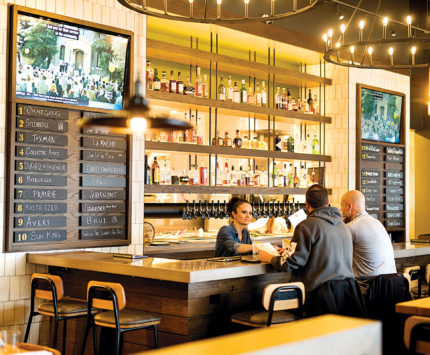The Hoosierist: A Courthouse Roof Tree, Supercomputers, And Indiana’s Caves

I call BS on the famous tree that lives in the Greensburg courthouse roof. Are we supposed to believe it has been there for a century and never gotten bigger?
Actually, a tree has occupied that spot for more like a century and a half. But no one’s claiming it’s the same sprout that locals first noticed poking out of the Greensburg courthouse tower in the 1870s. After years of life (and service as a tourist attraction), that sapling died in the early 20th century. In the meantime, another tree—the one that’s there now—has taken root on the tower’s south side. The Decatur County Visitors Commission spends about $5,000 annually on its care, including regular visits from an arborist. Recently, a Purdue University expert stated that the tree is “almost certainly” a mulberry. Which explains a lot, because mulberries—which are attempting to colonize the cracks in the Hoosierist’s patio—can survive pretty much anywhere.
What’s the most powerful super-computer in Indiana?
The state’s fastest number cruncher is housed at Indiana University. The recently installed Big Red 200, which looks like a row of crimson-colored vending machines, is billed as the speediest university-owned supercomputer in the nation. Named in honor of IU’s 200th anniversary, it replaces the Big Red II supercomputer, which was no longer nimble enough to keep up with the cutting-edge research the school’s faculty and students use it for. How quick is the school’s new electronic brain? If everybody in the state performed one calculation per second 24 hours a day, 365 days a year, it would still take 28 years to perform the same number of calculations Big Red 200 can do in a second. Those sound like Skynet numbers, but they won’t keep Big Red 200 on top for long. The original Big Red, which debuted just 15 years ago, was 1/300th the speed of today’s model.
Indiana has lots of underground caverns, but nothing that rivals Kentucky’s Mammoth Cave. Why?
As with other natural wonders such as beaches and mountains, Indiana just got the short end of the stick. While the Indiana Cave Survey lists some 4,000 caves, many are small and hard to access. Most are found in the state’s southern portion, where a thick band of near-surface limestone, called karst, has been eroded into countless underground voids. According to Julian Lewis, president of the Indiana Karst Conservancy, the limestone formation that created Mammoth Cave extends far into Indiana and includes the Binkley
Cave System near Corydon. But its tiny passages and sheer drops mean that large swaths of it are inaccessible to anyone who hates tight spaces.
Have Indiana-related questions? Send them to hoosierist@indianapolismonthly.com.





